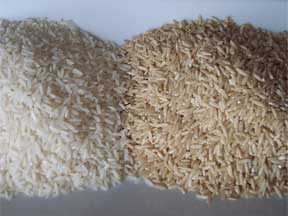|
| |

HEALTHY FOODS — By Mini
Padikkal — Rice is often the first solid food offered to an infant. It is the
least allergenic grain and that is why often recommended as a first introductory
food. Brown rice has more nutrition than regular white rice because in brown
rice only the outermost layer (husk) is removed. In white rice bran layer and
germ — which are rich in essential nutrients — are also removed. Let us see the
health benefits brown rice offers us. Whole-grain brown rice contains all three
layers of the kernel-the bran, germ and endosperm — which provides superior
nutrition value over white rice. Brown rice is rich in lignans, phytoestrogens
and phenolic compounds that are high in antioxidant activity. Most people
associate antioxidants with blueberries and green tea, but many are unaware that
brown rice is also a source of antioxidants.
Brown rice contains important nutrients such as thiamine, niacin, phosphorus,
potassium, iron, riboflavin and five times the fibre of white rice. A cup of the
nutrient-rich grain provides you with 14 per cent of recommended dietary
allowance (RDA) of fibre. One of the main health purposes of eating high-fibre
diets is they are natural remedy for constipation problems. It contains useful B
vitamin to help convert food into energy and keep the nervous system healthy.
The germ provides natural vitamin E.
• Regular consumption of brown rice and other whole grains has been shown to
help prevent heart disease, diabetes and some cancers. It is a good source of
fibre and reasonably low glycaemic index food that can control blood sugar
levels and may be helpful for diabetics. Unlike stripped rice, brown rice can
help keep blood sugar stabilised, as it releases sugars slowly and in a
sustained fashion. This makes it a better option for diabetics, as compared to
white rice. While studies in Asia have shown a link between the consumption of
white rice and risk of Type-2 Diabetes, new research shows that individuals who
eat at least two servings of brown rice weekly can reduce their chances of
developing Type 2 Diabetes by up to 11 per cent.
• Unlike white rice, brown rice retains its wholeness. Studies show that six
servings of whole grains weekly can lower the creation of arterial plaque
build-up and reduce chances of developing heart disease and high cholesterol.
The bran of rice contains the phyto chemicals that may reduce cholesterol.
• A study report published by the America Journal of Clinical Nutrition in 2003
mentioned the significant role of brown rice in maintaining an ideal body
weight. Women who consumed brown rice regularly were found to weigh less
compared to those who had not. For weight loss, you should consider replacing
your white rice with brown rice.
• Abundant with a compound known as folacin, brown rice promotes the production
of red blood cells. Besides, folacin has a list of wonderful health facts. It
also assists in the development of spinal cord and brain of the unborn baby.
• Brown rice has a good source of selenium. The high amount of fibre in brown
rice is excellent for cleansing the colon. Selenium present in brown rice has
been shown to substantially reduce the risk of colon cancer.
• One cup of brown rice gives us over 80 per cent of our daily manganese
requirements. This mineral helps the human body create the important fatty acids
that make healthy forms of cholesterol. It is also beneficial to the health of
our nervous and reproductive systems.
• Brown rice helps to prevent Gallstones. Eating foods high in insoluble fibre,
such as brown rice, can help women avoid gallstones, shows a study published in
the American Journal of Gastroenterology.
When buying brown rice, look for the expiry date as brown rice tends to get
rancid soon. The essential oil in the germ of the rice is very susceptible to
oxidation and soon goes rancid. Freezing or refrigeration will greatly extend
its storage life. Just making the switch from white rice to brown rice is a
great first step to healthy diet.
(The writer is a dietician at Atlas star Medical Centre, Al Khuwair, Muscat)
( Courtesy: The Oman Observer.
Read the article )
Articles
| |
|



